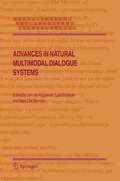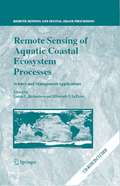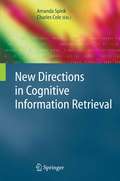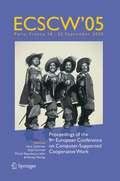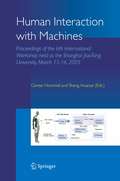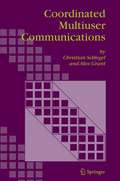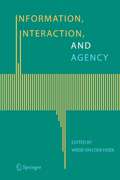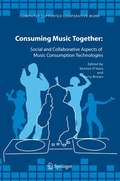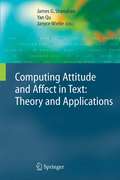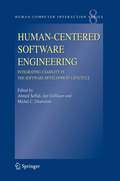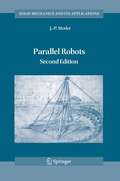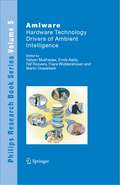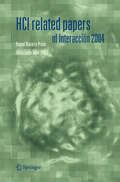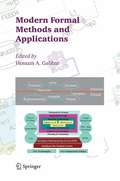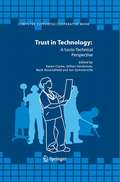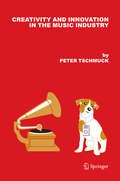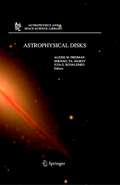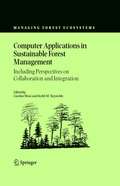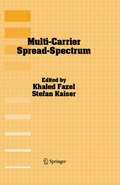- Table View
- List View
Abductive Reasoning: Logical Investigations into Discovery and Explanation (Synthese Library #330)
by Atocha AlisedaAbductive Reasoning: Logical Investigations into Discovery and Explanation is a much awaited original contribution to the study of abductive reasoning, providing logical foundations and a rich sample of pertinent applications. Divided into three parts on the conceptual framework, the logical foundations, and the applications, this monograph takes the reader for a comprehensive and erudite tour through the taxonomy of abductive reasoning, via the logical workings of abductive inference ending with applications pertinent to scientific explanation, empirical progress, pragmatism and belief revision.
Advances in Natural Multimodal Dialogue Systems (Text, Speech and Language Technology #30)
by Jan Van Kuppevelt Laila Dybkjær Niels Ole BernsenThe main topic of this volume is natural multimodal interaction. The book is unique in that it brings together a great many contributions regarding aspects of natural and multimodal interaction written by many of the important actors in the field. Topics addressed include talking heads, conversational agents, tutoring systems, multimodal communication, machine learning, architectures for multimodal dialogue systems, systems evaluation, and data annotation.
Remote Sensing of Aquatic Coastal Ecosystem Processes: Science and Management Applications (Remote Sensing and Digital Image Processing #9)
by Laurie L. Richardson Ellsworth F. LeDrewThe aquatic coastal zone is one of the most challenging targets for environmental remote sensing. Properties such as bottom reflectance, spectrally diverse suspended sediments and phytoplankton communities, diverse benthic communities, and transient events that affect surface reflectance (coastal blooms, runoff, etc.) all combine to produce an optical complexity not seen in terrestrial or open ocean systems. Despite this complexity, remote sensing is proving to be an invaluable tool for "Case 2" waters. This book presents recent advances in coastal remote sensing with an emphasis on applied science and management. Case studies of the operational use of remote sensing in ecosystem studies, monitoring, and interfacing remote sensing/science/management are presented. Spectral signatures of phytoplankton and suspended sediments are discussed in detail with accompanying discussion of why blue water (Case 1) algorithms cannot be applied to Case 2 waters.AudienceThis book is targeted for scientists and managers interested in using remote sensing in the study or management of aquatic coastal environments. With only limited discussion of optics and theory presented in the book, such researchers might benefit from the detailed presentations of aquatic spectral signatures, and to operational management issues. While not specifically written for remote sensing scientists, it will prove to be a useful reference for this community for the current status of aquatic coastal remote sensing.
New Directions in Cognitive Information Retrieval (The Information Retrieval Series #19)
by Amanda Spink Charles ColeNew Directions in Cognitive Information Retrieval presents an exciting new direction for research into cognitive oriented information retrieval (IR) research, a direction based on an analysis of the user’s problem situation and cognitive behavior when using the IR system. This contrasts with the current dominant IR research paradigm which concentrates on improving IR system matching performance. The chapters describe the leading edge concepts and models of cognitive IR that explore the nexus between human cognition, information and the social conditions that drive humans to seek information using IR systems. Chapter topics include: Polyrepresentation, cognitive overlap and the boomerang effect, Multitasking while conducting the search, Knowledge Diagram Visualizations of the topic space to facilitate user assimilation of information, Task, relevance, selection state, knowledge need and knowledge behavior, search training built into the search, children’s collaboration for school projects, and other cognitive perspectives on IR concepts and issues.
ECSCW 2005: Proceedings of the Ninth European Conference on Computer-Supported Cooperative Work, 18-22 September 2005, Paris, France
by Hans Gellersen Kjeld Schmidt Michel Beaudouin-Lafon Wendy MackayThe emergence and widespread use personal computers and network technologies have seen the development of interest in the use of computers to support cooperative work. This volume presents the proceedings of the ninth European conference on Computer Supported Cooperative Work (CSCW). This is a multidisciplinary area that embraces the development of new technologies grounded in actual cooperative practices. These proceedings contain a collection of papers that reflect the variegated research activities in the field. The volume includes papers addressing novel interaction technologies for CSCW systems, new models and architectures for groupware systems, studies of communication and coordination among mobile actors, studies of cooperative work in complex settings, studies of groupware systems in actual use in real-world settings, and theories and techniques to support the development of cooperative applications. The papers present emerging technologies alongside new methods and approaches to the development of this important class of applications. The work in this volume represents the best of the current research and practice within CSCW. The collection of papers presented here will appeal to researchers and practitioners alike, as they combine an understanding of the nature of work with the possibility offered by new technologies.
Human Interaction with Machines: Proceedings of the 6th International Workshop held at the Shanghai JiaoTong University, March 15-16, 2005
by G. Hommel Sheng HuanyeThe International Workshop on “Human Interaction with Machines” is the sixth in a successful series of workshops that were established by Shanghai Jiao Tong University and Technische Universität Berlin. The goal of those workshops is to bring together researchers from both universities in order to present research results to an international community. The series of workshops started in 1990 with the International Workshop on “Artificial Intelligence” and was continued with the International Workshop on “Advanced Software Technology” in 1994. Both workshops have been hosted by Shanghai Jiaotong University. In 1998 the third wo- shop took place in Berlin. This International Workshop on “Communi- tion Based Systems” was essentially based on results from the Graduiertenkolleg on Communication Based Systems that was funded by the German Research Society (DFG) from 1991 to 2000. The fourth Int- national Workshop on “Robotics and its Applications” was held in Sha- hai in 2000. The fifth International Workshop on “The Internet Challenge: Technology and Applications” was hosted by TU Berlin in 2002.
Coordinated Multiuser Communications
by CHRISTIAN SCHLEGEL Alex GrantCoordinated Multiuser Communications provides for the first time a unified treatment of multiuser detection and multiuser decoding in a single volume. Many communications systems, such as cellular mobile radio and wireless local area networks, are subject to multiple-access interference, caused by a multitude of users sharing a common transmission medium. The performance of receiver systems in such cases can be greatly improved by the application of joint detection and decoding methods. Multiuser detection and decoding not only improve system reliability and capacity, they also simplify the problem of resource allocation. Coordinated Multiuser Communications provides the reader with tools for the design and analysis of joint detection and joint decoding methods. These methods are developed within a unified framework of linear multiple-access channels, which includes code-division multiple-access, multiple antenna channels and orthogonal frequency division multiple access. Emphasis is placed on practical implementation aspects and modern iterative processing techniques for systems both with, and without integrated error control coding. Focusing on the theory and practice of unifying accessing and transmission aspects of communications, this book is a valuable reference for students, researchers and practicing engineers.
Information, Interaction, and Agency
by Wiebe Van Der HoekContemporary epistemological and cognitive studies, as well as recent trends in computer science and game theory have revealed an increasingly important and intimate relationship between Information, Interaction, and Agency. Agents perform actions based on the available information and in the presence of other interacting agents. From this perspective Information, Interaction, and Agency neatly ties together classical themes like rationality, decision-making and belief revision with games, strategies and learning in a multi-agent setting. Unified by the central notions Information, Interaction, and Agency, the essays in this volume provide refreshing methodological perspectives on belief revision, dynamic epistemic logic, von Neumann games, and evolutionary game theory; all of which in turn are central approaches to understanding our own rationality and that of other agents.
Consuming Music Together: Social and Collaborative Aspects of Music Consumption Technologies (Computer Supported Cooperative Work #35)
by Barry Brown Kenton O'HaraListening to, buying and sharing music is an immensely important part of everyday life. Yet recent technological developments are increasingly changing how we use and consume music. This book collects together the most recent studies of music consumption, and new developments in music technology. It combines the perspectives of both social scientists and technology designers, uncovering how new music technologies are actually being used, along with discussions of new music technologies still in development. With a specific focus on the social nature of music, the book breaks new ground in bringing together discussions of both the social and technological aspects of music use. Chapters cover topics such as the use of the iPod, music technologies which encourage social interaction in public places, and music sharing on the internet. A valuable collection for anyone concerned with the future of music technology, this book will be of particular interest to those designing new music technologies, those working in the music industry, along with students of music and new technology.
Computing Attitude and Affect in Text: Theory and Applications (The Information Retrieval Series #20)
by James G. Shanahan Yan Qu Janyce WiebeHuman Language Technology (HLT) and Natural Language Processing (NLP) systems have typically focused on the “factual” aspect of content analysis. Other aspects, including pragmatics, opinion, and style, have received much less attention. However, to achieve an adequate understanding of a text, these aspects cannot be ignored. The chapters in this book address the aspect of subjective opinion, which includes identifying different points of view, identifying different emotive dimensions, and classifying text by opinion. Various conceptual models and computational methods are presented. The models explored in this book include the following: distinguishing attitudes from simple factual assertions; distinguishing between the author’s reports from reports of other people’s opinions; and distinguishing between explicitly and implicitly stated attitudes. In addition, many applications are described that promise to benefit from the ability to understand attitudes and affect, including indexing and retrieval of documents by opinion; automatic question answering about opinions; analysis of sentiment in the media and in discussion groups about consumer products, political issues, etc. ; brand and reputation management; discovering and predicting consumer and voting trends; analyzing client discourse in therapy and counseling; determining relations between scientific texts by finding reasons for citations; generating more appropriate texts and making agents more believable; and creating writers’ aids. The studies reported here are carried out on different languages such as English, French, Japanese, and Portuguese. Difficult challenges remain, however. It can be argued that analyzing attitude and affect in text is an “NLP”-complete problem.
Human-Centered Software Engineering - Integrating Usability in the Software Development Lifecycle (Human–Computer Interaction Series #8)
by Ahmed Seffah Jan Gulliksen Michel C. DesmaraisHuman-CenteredSoftwareEngineering: BridgingHCI,UsabilityandSoftwareEngineering From its beginning in the 1980’s, the ?eld of human-computer interaction (HCI) has beende?nedasamultidisciplinaryarena. BythisImeanthattherehas beenanexplicit recognition that distinct skills and perspectives are required to make the whole effort of designing usable computer systems work well. Thus people with backgrounds in Computer Science (CS) and Software Engineering (SE) joined with people with ba- grounds in various behavioral science disciplines (e. g. , cognitive and social psych- ogy, anthropology)inaneffortwhereallperspectiveswereseenasessentialtocreating usable systems. But while the ?eld of HCI brings individuals with many background disciplines together to discuss a common goal - the development of useful, usable, satisfying systems - the form of the collaboration remains unclear. Are we striving to coordinate the varied activities in system development, or are we seeking a richer collaborative framework? In coordination, Usability and SE skills can remain quite distinct and while the activities of each group might be critical to the success of a project, we need only insure that critical results are provided at appropriate points in the development cycle. Communication by one group to the other during an activity might be seen as only minimally necessary. In collaboration, there is a sense that each group can learn something about its own methods and processes through a close pa- nership with the other. Communication during the process of gathering information from target users of a system by usability professionals would not be seen as so- thing that gets in the way of the essential work of software engineering professionals.
Parallel Robots (Solid Mechanics and Its Applications #128)
by J.P. MerletParallel robots are closed-loop mechanisms presenting very good performances in terms of accuracy, velocity, rigidity and ability to manipulate large loads. They have been used in a large number of applications ranging from astronomy to flight simulators and are becoming increasingly popular in the field of machine-tool industry. This book presents a complete synthesis of the latest results on the possible mechanical architectures, analysis and synthesis of this type of mechanism. It is intended to be used by students (with over 150 exercises and numerous internet addresses), researchers (with over 650 references and anonymous ftp access to the code of some algorithms presented in this book) and engineers (for which practical results, mistakes to avoid, and applications are presented). Since the publication of the first edition (2000) there has been an impressive increase in terms of study and use of this kind of structure that are reported in this book. This second edition has been completely overhauled. The initial chapter on kinematics has been split into Inverse Kinematics and Direct Kinematics. A new chapter on calibration was added. The other chapters have also been rewritten to a large extent. The reference section has been updated to include around 45% new works that appeared after the first edition.
Information Technology and Lawyers: Advanced Technology in the Legal Domain, from Challenges to Daily Routine
by Arno R. Lodder Anja OskampThe gap between information technology and the legal profession is narrowing, in particular due to the Internet and the richness of legal sources that can be found online. This book further bridges the gap by showing people with a legal background what is possible with Information Technology now and in the near future, as well as by showing people with an IT background what opportunities exist in the domain of law.
Computer Vision and Graphics: International Conference, ICCVG 2004, Warsaw, Poland, September 2004, Proceedings (Computational Imaging and Vision #32)
by K. Wojciechowski B. Smolka H. Palus R. S. Kozera W. Skarbek L. NoakesAs the speed, capabilities, and economic advantages of modern digital devices c- tinue to grow, the need for ef?cient information processing, especially in computer - sion and graphics, dramatically increases. Growth in these ?elds stimulated by eme- ing applications has been both in concepts and techniques. New ideas, concepts and techniques are developed, presented, discussed and evaluated, subsequently expanded or abandoned. Such processes take place in different forms in various ?elds of the c- puter science and technology. The objectives of the ICCVG are: presentation of current research topics and d- cussions leading to the integration of the community engaged in machine vision and computer graphics, carrying out and supporting research in the ?eld and ?nally pro- tion of new applications. The ICCVG is a continuation of the former International Conference on Computer Graphics and Image Processing called GKPO, held in Poland every second year in May since 1990, organized by the Institute of Computer Science of the Polish Academy of Sciences, Warsaw and chaired by the Editor of the International Journal of Machine Graphics and Vision, Prof. Wojciech S. Mokrzycki.
AmIware: Hardware Technology Drivers of Ambient Intelligence (Philips Research Book Series #5)
by Satyen Mukherjee Emile Aarts Raf Roovers Frans Widdershoven Martin OuwerkerkAmbient Intelligence is one of the new paradigms in the development of information and communication technology, which has attracted much attention over the past years. The aim is the to integrate technology into people environment in such a way that it improves their daily lives in terms of well-being, creativity, and productivity. Ambient Intelligence is a multidisciplinary concept, which heavily builds on a number of fundamental breakthroughs that have been achieved in the development of new hardware concepts over the past years. New insights in nano and micro electronics, packaging and interconnection technology, large-area electronics, energy scavenging devices, wireless sensors, low power electronics and computing platforms enable the realization of the heaven of ambient intelligence by overcoming the hell of physics. Based on contributions from leading technical experts, this book presents a number of key topics on novel hardware developments, thus providing the reader a good insight into the physical basis of ambient intelligence. It also indicates key research challenges that must be addressed in the future.
HCI related papers of Interacción 2004
by Raquel Navarro-Prieto Jesús Lorés-VidalThe present book contains a collection of the best papers presented at the 5th International Conference on Interacción Persona Ordenador (IPO) (which is Human Computer Interaction in Spanish), which took place in th th Lleida on May 5 -7 , 2004. This conference was co-organised by the Universitat of Lleida and the Universitat Oberta de Catalunya. Each year this conference is promoted by the Asociación para la Interacción Persona Ordenador (AIPO), the Spanish Human Computer Interaction Association, in collaboration with the local group of ACM- SIGCHI (CHISPA). In its fifth edition this conference has become a multidisciplinary forum for the discussion and dissemination of novelty research in Human Computer Interaction. The main goals of Interacción 2004 were: To expand the conference scope with internationally recognised invited speakers. The plenary talks were presented by Alan Dix, Yvonne Rogers, Geritt van der Veer, and Angel Puerta. To open the participation to Spanish speaker worldwide in order to be a point of reference of this discipline not only in Spain but also in the wider Spanish speaking community. This goal was reached through a very diverse program which included panels and posters sessions, where many different aspect of the Human Computer Interaction (HCI) were presented. All through the program, research from outside Spain was reflected through the contributions from people of other countries.
Modern Formal Methods and Applications
by Hossam A. GabbarFormal methods are a robust approach for problem solving. It is based on logic and algebraic methods where problems can be formulated in a way that can help to find an appropriate solution. This book shows the basic concepts of formal methods and highlights modern modifications and enhancements to provide a more robust and efficient problem solving tool. Applications are presented from different disciplines such as engineering where the operation of chemical plants is synthesized using formal methods. Computational biology becomes easier and systematic using formal methods. Also, hardware compilation and systems can be managed using formal methods. This book will be helpful for both beginners and experts to get insights and experience on modern formal methods by viewing real applications from different domains.
Trust in Technology: A Socio-Technical Perspective (Computer Supported Cooperative Work #36)
by Karen Clarke Gillian Hardstone Mark Rouncefield Ian SommervilleComputer systems can only deliver benefits if functionality, users and usability are central to their design and deployment. This book encapsulates work done in the DIRC project (Interdisciplinary Research Collaboration in Dependability), bringing together a range of disciplinary approaches - computer science, sociology and software engineering - to produce a socio-technical systems perspective on the issues surrounding trust in technology in complex settings.
Creativity and Innovation in the Music Industry
by Peter TschmuckThis book charts the effects of new communication technologies and the Internet on the creation of music in the early 21st century. It examines how the music industry will be altered by the Internet, music online services and MP3-technology. This is done through an integrated model based on an international history of the industry since the phonograph’s invention in 1877, and thus, the history of the music industry is described in full detail for the first time.
Advances in Sensing with Security Applications (Nato Security through Science Series A: #Vol. 2)
by Jim ByrnesThe chapters in this volume were presented at the July 2005NATO Advanced Study Institute on Advances in Sensing with Security App- cations. The conference was held at the beautiful Il Ciocco resort near Lucca, in the glorious Tuscany region of northern Italy. Once again we gathered at this idyllic spot to explore and extend the reciprocity between mathematics and engineering. The dynamic interaction - tween world-renowned scientists from the usually disparate communities of pure mathematicians and applied scientists which occurred at our six previous ASI’s continued at this meeting. The fusion of basic ideas in mathematics, biology, and chemistry with ongoing improvements in hardware and computation o?ers the promise of much more sophisticated and accurate sensing capabilities than c- rently exist. Coupled with the dramatic rise in the need for surveillance in innumerable aspects of our daily lives, brought about by hostile acts deemed unimaginable only a few short years ago, the time was right for scientists in the diverse areas of sensing and security to join together in a concerted e?ort to combat the new brands of terrorism. This ASI was one important initial step. To encompass the diverse nature of the s- ject and the varied backgrounds of the anticipated participants, the ASI was divided into three broadly de?ned but interrelated areas: the - creasing need for fast and accurate sensing, the scienti?c underpinnings of the ongoing revolution in sensing, and speci?c sensing algorithms and techniques. The ASI brought together world leaders from academia, government, andindustry,withextensivemultidisciplinarybackgroundsevidencedby theirresearchandparticipationinnumerousworkshopsandconferences.
Astrophysical Disks: Collective and Stochastic Phenomena (Astrophysics and Space Science Library #337)
by Aleksey M. Fridman Mikhail Ya Marov Ilya G. KovalenkoThis book deals with collective and stochastic processes in astrophysical disks involving theory, observations, and the results of modelling. It examines the spiral-vortex structure in galactic and accretion disks, and stochastic and ordered structures in developed turbulence. The book advances the study in this important branch of astrophysics and will benefit professional researchers, lecturers, and graduate students.
Critical Infrastructures at Risk: Securing the European Electric Power System (Topics in Safety, Risk, Reliability and Quality #9)
by A.V. Gheorghe M. Masera M. Weijnen L.J. De VriesEurope witnessed in the last years a number of significant power contingencies. Some of them revealed the potentiality of vast impact on the welfare of society and triggered pressing questions on the reliability of electric power systems. Society has incorporated electricity as an inherent component, indispensable for achieving the expected level of quality of life. Therefore, any impingement on the continuity of the electricity service would be able to distress society as a whole, affecting individuals, social and economic activities, other infrastructures and essential government functions. It would be possible to hypothesize that in extreme situations this could even upset national security. This book explores the potential risks and vulnerabilities of the European electricity infrastructure, other infrastructures and our society as whole increasingly depend on. The work was initiated by the need to verify the potential effects of the ongoing market and technical transformation of the infrastructure, which is fundamentally changing its operation and performance. The final aim is to set the basis for an appropriate industrial and political European-wide response to the risk challenges.
Computer Applications in Sustainable Forest Management: Including Perspectives on Collaboration and Integration (Managing Forest Ecosystems #11)
by Guofan Shao Keith M. ReynoldsThis book is the most comprehensive and up-to-date treatment of computer applications in forestry. It is the first text on software for forest management to emphasize integration of computer applications. It also offers important new insights on how to continue advancing computational technologies in forest management. The authors are internationally-recognized authorities in the subjects presented.
Programming for Peace: Computer-Aided Methods for International Conflict Resolution and Prevention (Advances in Group Decision and Negotiation #2)
by Robert TrapplSadly enough, war, conflicts and terrorism appear to stay with us in the 21st century. But what is our outlook on new methods for preventing and ending them? Present-day hard- and software enables the development of large crisis, conflict, and conflict management databases with many variables, sometimes with automated updates, statistical analyses of a high complexity, elaborate simulation models, and even interactive uses of these databases. In this book, these methods are presented, further developed, and applied in relation to the main issue: the resolution and prevention of intra- and international conflicts. Conflicts are a worldwide phenomenon. Therefore, internationally leading researchers from the USA, Austria, Canada, Germany, New Zealand and Switzerland have contributed.

